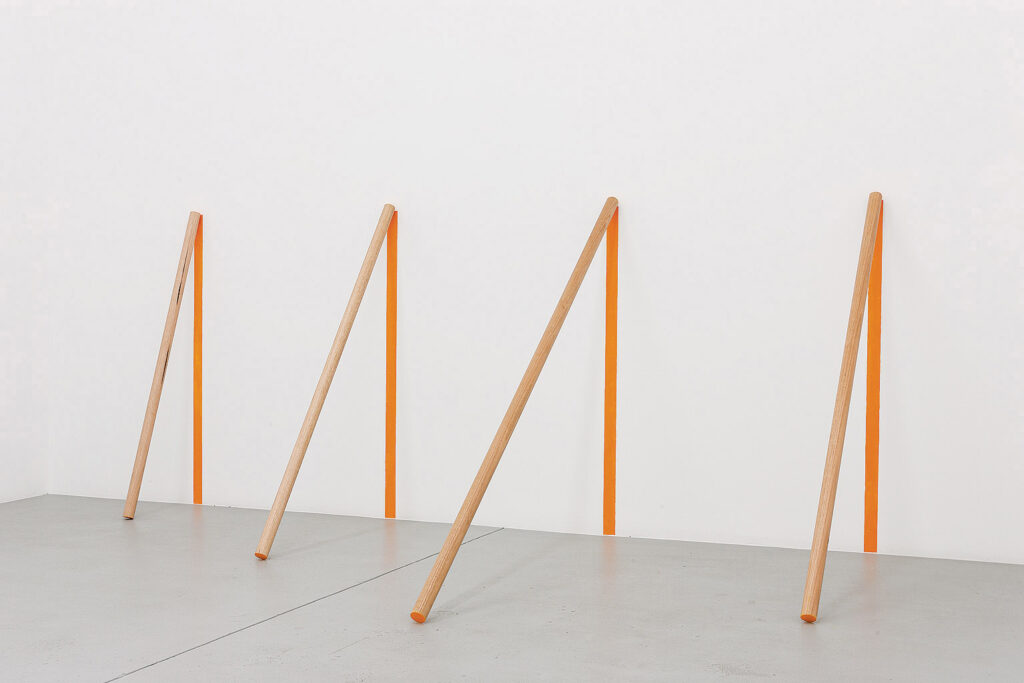
Agatha Gothe-Snape
Four Parts
Kalimanrawlins, Melbourne
4 February – 2 March 2012
Agatha Gothe-Snape is something of an anti-hero in a line of work defined by individualism. An artist whose work has almost always been commemorative, she has long been concerned with acknowledging artists in Australia and contemplating their collective worth. Drawing on and drawing in her precursors and contemporaries, her ardently cross-disciplinary practice attributes great importance to the social dimension of art-making and is expressly sympathetic to repeating other practitioners in the interest of her own voice. Her works include an ongoing poster series in which she has branded the names of local and international artists with logos in an analogous design, a typographic series titled I Trusted You 2009, a verbatim transcription of Andy Kaufman’s show tune of the same name, and the continuing Every Artist Remembered 2009–2012 project, in which the names of artists are recollected and recorded during two-hour-long two-person dialogues between Gothe-Snape and another artist. These diverse activities have been determined with regards to being ‘the most direct medium’1 and ‘the most economic means’2 for giving form to an idea. Her most recent exhibition, Four Parts at Kalimanrawlins, marked a departure from the kind of charity and historicism of these aforementioned projects with new, and obscure, work.
Four Parts comprised a series of framed gouache vignettes: highly stylised still-lifes that repeated and re-purposed basic shapes to appear as cartoon layouts reminiscent of the Hanna-Barbara age of animation. The works’ schmaltzy titles — for example, Large glass sits between two unhappy chairs 2012 and Full moon rises in martini as ball and chair watch 2012 — attribute human characteristics to the furnishings and tableware that figure in the images. Beside the paintings, in a Flash animation titled Falling straws 2012, yellow-striped rectangles track downward in pictorial space, displayed on a digital media frame and meta-framed in a timber case that tones with the paintings. Upon an adjacent wall, four different lengths of dowel angle away from four yellow-painted stripes, emerging as a kind of anamorphic graph. A moving play for 4 parts written and directed by Agatha Gothe-Snape 2011 consists of a tableau vivant of four plain-clothed performers standing mutely in a lineup, each thinking a line that corresponds with the titles of the four gouache paintings. The actors performed at regular intervals during the opening night of the exhibition, breaking to mingle with the opening party.
As an exercise in style, Four Parts was undeniably strong: sleek, matte, fastidiously coordinated, a semblance of graphic and domestic geometry. Artwork this vague and decorative, however, marks an exercise that doesn’t necessarily wash with the artist’s strategy of directness and economy. At its most definitive, Four Parts explores the ‘precarity of meaning’^3 through works that are ‘over the top’.4 Considering this, you might expect an audience to be in two minds about being overwhelmed by subjectivity.
Gothe-Snape takes some pleasure in the thought of viewers traipsing around Four straws partially obscured contemplating the unit used to measure the inclining dowel. This work is what you might call ‘a device to produce movement’,5 an invitation to engage with an object. But, instead, it cries wolf and, strangely, Gothe-Snape’s artist statement expresses her desire to see it toppled.6 Her statement also voices her ‘[reluctance] to make [the] paintings, to make anything at all’7 and her passive relationship to the ‘things [that] manage to propel themselves onto the surface of the paper’8 is, perhaps, a privy detraction from deciphering the works. In considering the show’s most poignant intrapersonal feature, A moving play for 4 parts written and directed by Agatha Gothe-Snape, the audience is duped into a kind of ‘dance in search of meaning’.9 Perhaps this reticence is all very amusing or sagacious, but, given the pretext, is it a little patronising?
Gothe-Snape’s previous works in gouache have publicised events and professionals, studiedly charted emotional states and instructed gallery attendees. Her paintings have been unified in their directness and minimalism, thus we approach these new paintings expecting a certain level of didacticism. These still-lifes are markedly different. Intuitive or unthinking, these paintings are perhaps intended to be the flypaper for the viewers’ musings. David Campany proposes that through ‘mobilising desires and expressing tastes’, the ‘still-life bridges art and commerce’,10 and, in this way, what these gouache works do convey is a tremendous longing for a union with the kind of cosmopolitan living rooms they describe.
Considering Gothe-Snape’s work has hitherto been heavily informed by the colour theories of Goethe, Lüscher and Plutchik, it’s fair to ask why this exhibition has a colour scheme. It appears that yellow has become the artist’s IKB®, and its lavishings are a little glib. This ‘room theme’ recasts the installation as an interior and reveals an interest in current aesthetic trends and the viewer’s navigation of the gallery (a theme Gothe-Snape has addressed through numerous prior performances). Interior designs aren’t necessarily declarative in the way we expect art to be — visual signifiers are employed to activate and decorate a space, or extend a brand experience; this is the light in which we read this body of work. Four Parts seemed to lack the breadth of history that Gothe-Snape has demonstrated that she can wield. It seemed to lack her inscrutable humour and the new-age uncouthness that has made her practice so intriguing, although, as an exercise in style, it is undeniably strong.
Matthew Greaves is a Melbourne-based artist.
